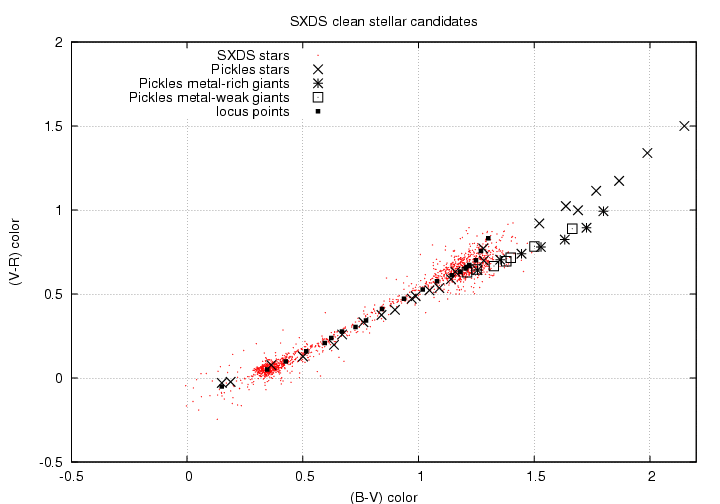
For earlier reports in this series, see
My goal is to perform in the SXDS field the same analysis I did for the SDF:
I have now added a bit of additional analysis, with simple statistics of stars and not-stars in the field; I also check for a bias in my classification algorithm which might discard faint, red stars from the SXDS catalogs (and do not find one).
I have finished my second version of analysis on the SXDS, using a new set of catalogs. These were kindly provided by Tomoki Morokuma on August 3, 2006. The new set differ from the previous ones mostly in small zero-point shifts in the magnitude scale; that is, the magnitudes of all objects in the i-band might be 0.03 larger in the new catalogs than in the old catalogs. However, I also noticed a more significant change: the 2.0-arcsec aperture magnitudes for all objects in all passbands were completely different from the old ones. They were not simply shifted by a constant amount: the values for each object were slightly different, by different amounts.
According to Morokuma-san,
These are in version 1, and the most reliable ones.
The MD5 checksums for these new versions of the catalogs are
114192 -rw-rw-r-- 1 richmond richmond 116805844 Aug 3 00:23 sxdsi1.cat f0d8dcdda852edcd3ac2f2e526c8d55e 111068 -rw-rw-r-- 1 richmond richmond 113607491 Aug 3 00:23 sxdsi2.cat 874f06b619ec4ae34d1ec4a3aaf85797 118256 -rw-rw-r-- 1 richmond richmond 120964971 Aug 3 00:24 sxdsi3.cat 468ed014a0f1e7e0d5a17c9df02a713d 110464 -rw-rw-r-- 1 richmond richmond 112992477 Aug 3 00:24 sxdsi4.cat 8edef9c53fc343d89535ad3de25aac6f 112560 -rw-rw-r-- 1 richmond richmond 115136051 Aug 3 00:24 sxdsi5.cat dead29d921ddaacee4bdcfefe1915c5a
As before, I used catalogs of the SXDS images based on the i'-band detections. The first step was to create a stellar locus. I picked colors (B-V), (V-R) and (R-i'). I chose a sample of objects which, based both on their morphology and on their colors, were very likely to be stars. I then applied the techniques described by
Below are graphs showing the locations of stars in the clean sample, the locus nodes derived from the stars, and positions of various stars or stellar models based on synthetic photometry in the Suprime-Cam passbands. I have shifted the synthetic photometry to match the actual locations of stars.

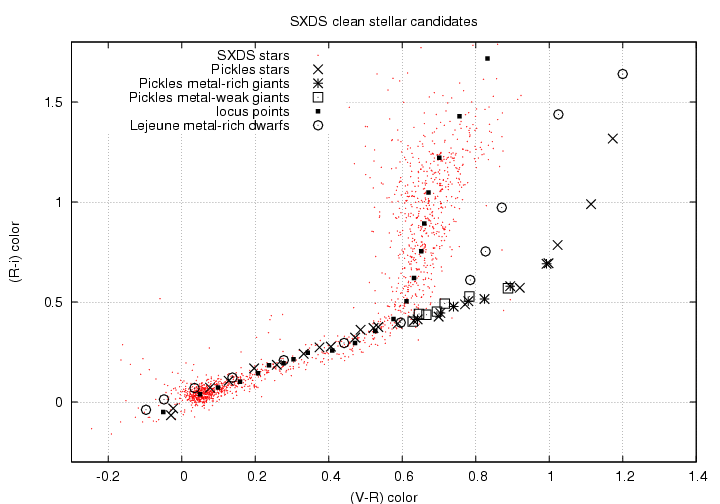
Note that none of the synthetic photometry seems to match the observations for the reddest stars. The observed locus bends much more sharply than the synthetic loci. I saw a similar effect in the SDF photometry. Some of the difference may be ascribed to differences in metallicity between the observed stars and the stars used in the synthetic photometry, but there may be additional differences due to other factors that I do not yet understand.
The locus created in this fashion has an ellipsoidal cross-section which may change size and orientation. Following the methods described in Richmond (2005), I used this locus to give a "color classification" to every object in the SXDS catalogs. If the colors of an object -- including observational uncertainties -- fell completely within the locus, I assigned a "color score" of 1.0 to the object, meaning it is consistent with stellar colors. If the colors of an object placed it completely outside the locus, I assigned it a "color score" of 0.0, meaning that is not consistent with stellar colors. Some objects had a location which fell partly within the locus when one included uncertainties; for such object, I assigned a score between 0.0 and 1.0, given by the fraction of the object's error ellipsoid which fell within the locus.
The i'-band catalogs for the five SXDS fields (Center, North, South, East, West) contain many, many objects. I discarded those which had invalid values for at least one magnitude or magnitude uncertainty, which left 780,826 entries. Some of these are repeated measurements of a single object in regions of overlap between two fields. I have not (yet) done anything about repeated entries for the same object.
The results of my classification can be found in the following files.
Let me list a few properties of objects classified in the SXDS. I'll also mention some of these properties for stars in the SDF (taken from Properties of stars in the Subaru Deep Field ).
shape color number fraction fraction score score in SXDS in SXDS in SDF name (out of 10) (out of 1.0) (780798) ------------------------------------------------------------------------------- 5 - 10 0.0 - 1.0 95542 12.2% 11.7% somewhat stellar shape 9 - 10 0.0 - 1.0 20275 2.6 3.4 very stellar shape 0 - 10 0.5 - 1.0 14745 1.9 1.4 somewhat stellar color 0 - 10 0.9 - 1.0 10142 1.3 1.1 very stellar color 5 - 10 0.5 - 1.0 7463 0.96 0.84 "low-quality" star 9 - 10 0.9 - 1.0 4152 0.53 0.56 "high-quality" star -------------------------------------------------------------------------------
Below, I break objects in these categories down by apparent V-band magnitude. Note that in order to be included in the classification process, an object had to have a valid measured magnitude in all five passbands: B, V, R, i, z. As explained in the paper on the SDF, stars with extreme colors will fail to be detected in at least one band starting at around magnitude V = 23, at which point the sample of classified objects becomes incomplete. See section 5 of the SDF paper for an explanation of how one can use theoretical models of the Milky Way's stellar population to deal with the incompleteness.
First, the raw number of objects in each category as a function of magnitude. The "morph only, low-quality" category corresponds to the first row of the table above; the "color only, low-quality" category corresponds to the third row of the table.
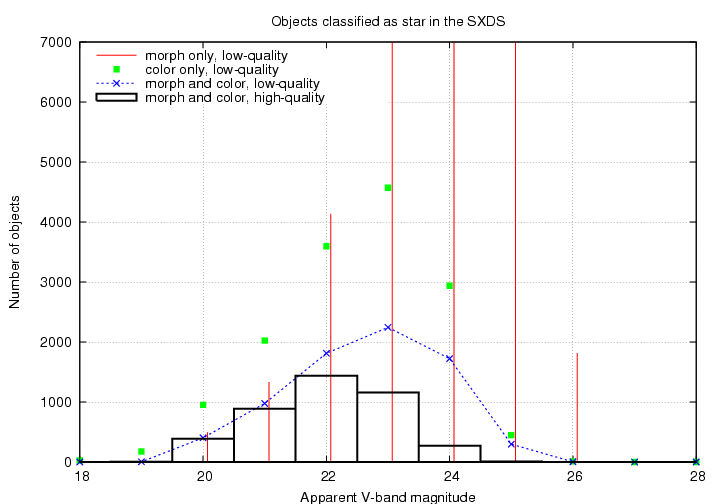
Now, the stars as a fraction of all classified objects. Note how much more stringent the color test is than the shape test at the faint end.
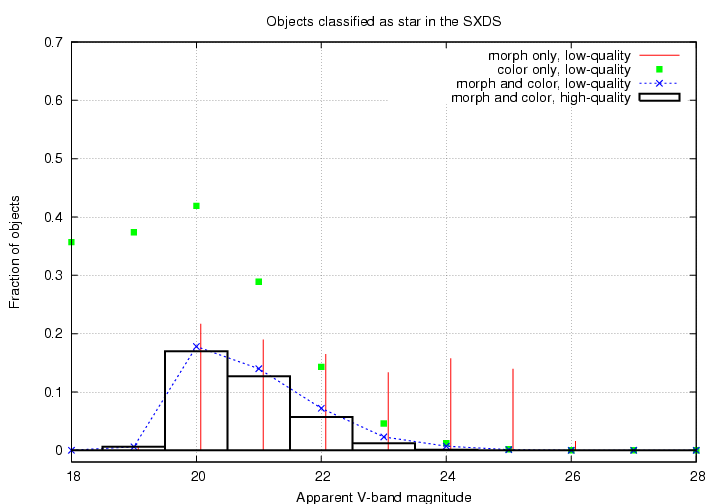
Is it possible that the classification algorithm is discarding a significant number of faint, red stars from the SXDS catalogs? Recall that in order for an object to be accepted for classification, it must have
Suppose that there were a large number of faint, red stars, so faint and so red that they appeared only in the redder images. In the SXDS catalogs, these objects would have invalid magnitudes in the blue bands (B and V), and so would not enter into the classification process.
To check for such a population, I first made a color-color diagram using only the reddest colors, (i-z) vs. (R-i). Note that I did not use any z-band data in the classification procedure -- so this diagram is new and different from my main work. Let's first look at the locus of "reliable" stars, which are almost definitely really stars. I show below the locus of the low-quality star sample, divided into "bright" and "faint" groups. There is a hint that the locus splits into two arms at the red end, probably due to disk stars and halo stars with different metallicities.
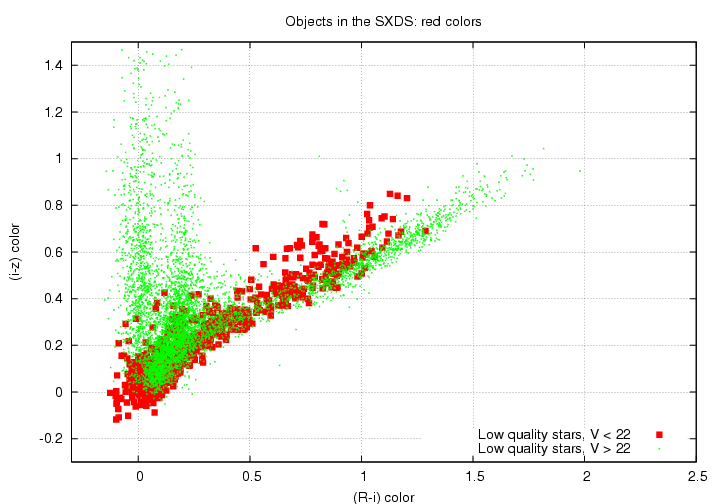
Now, let me place onto this diagram all the objects which were part of my algorithm's output and were classified as "not a star", due to a non-stellar shape and/or a non-stellar color.
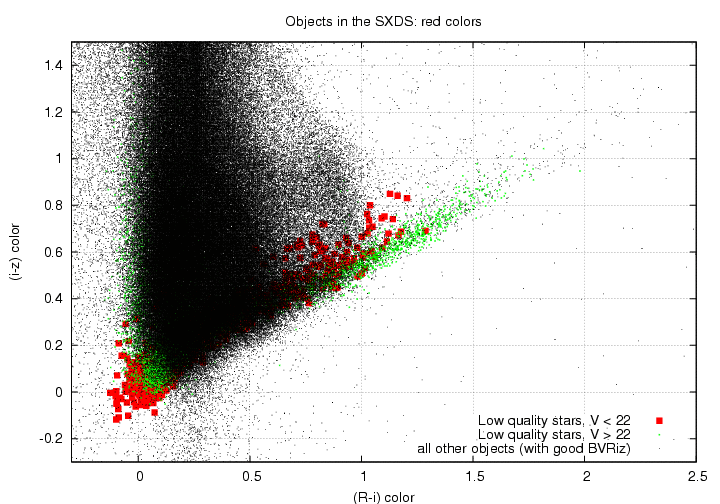
You can see that there are not very many additional objects which fall into the region we expect faint, red stars to inhabit. But could this be due to the selection bias in my procedure: could there be a group of very faint, very red objects in the original SXDS catalogs with missing B magnitudes?
We can check by going back to the original SXDS catalogs and plotting all the objects onto this diagram. If we see a big cluster of objects at the red end of the stellar locus in this (i-z) vs. (R-i) diagram, then my procedure might indeed have a significant selection bias. (For convenience, in the figure below, I plot only objects from the Center Field of the SXDS original catalogs)
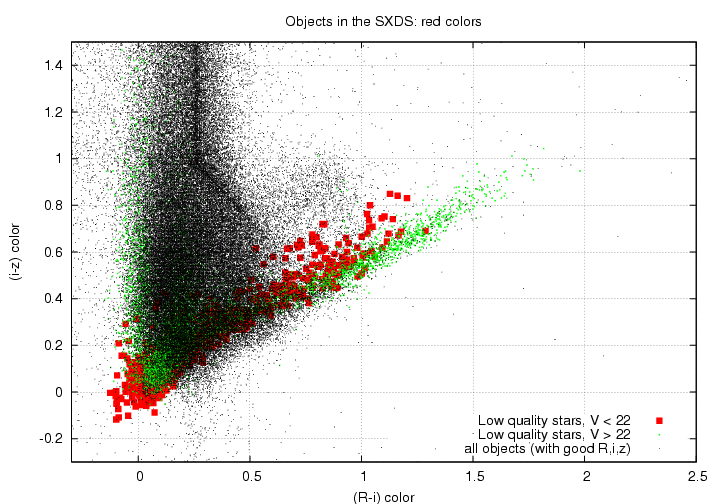
No, there is no big group of faint, red stars in the original SXDS catalogs which is removed during the process of classification.